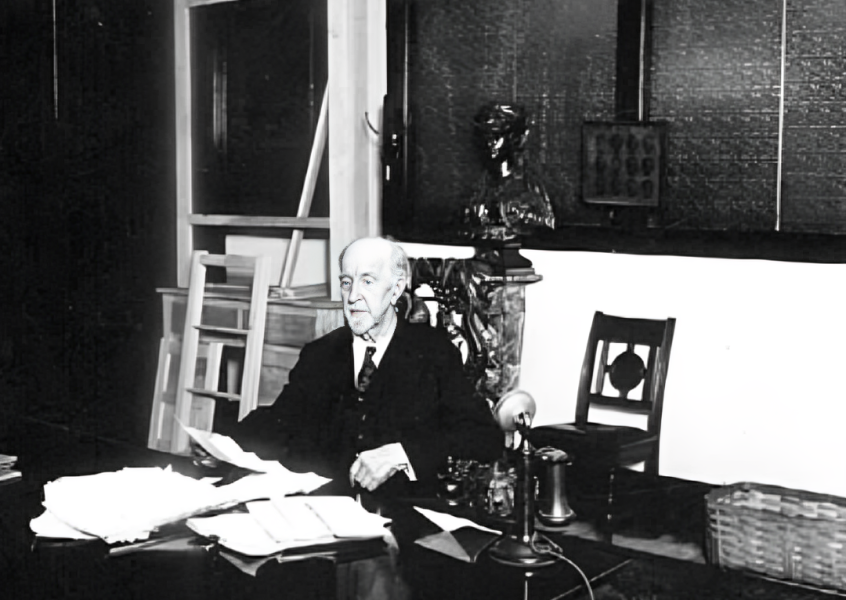Early Life and Education

Thomas Barlow Walker, better known as T. B. Walker, was born on February 1, 1840, in Xenia, Ohio. Raised in a modest household, Walker’s early years were shaped by adversity. In 1849, his father, Platt Walker, invested the family’s savings in a wagon train bound for the California Gold Rush but tragically died of cholera en route, leaving the family destitute. This forced Walker, then only nine years old, to take up work to help support his family. Despite these hardships, Walker’s insatiable thirst for knowledge saw him self-educating whenever he could.
By 1856, his family had relocated to Berea, Ohio, where Walker enrolled at Baldwin University. Juggling work and studies, Walker could afford only one term per year but made the most of his education, excelling in mathematics. It was during his time at Baldwin University that Walker met Harriet Granger Hulet, who would later become his wife. They married in 1863 and eventually had eight children.
Early Career and Lumber Industry Beginnings
T. B. Walker’s work experience during his college years was diverse, ranging from clerking in a store to selling grindstones. A key turning point came in 1862, when a misplaced shipment of grindstones led him to St. Paul, Minnesota. There, he met James J. Hill, a young clerk who would later become a railroad magnate. Acting on a tip, Walker made his way to Minneapolis, where he was hired as a surveyor by George B. Wright, a prominent land surveyor. This was a pivotal moment, as Walker gained invaluable knowledge of Minnesota’s rich pine forests, which would become the foundation of his future success in the lumber industry.
Though Walker was offered a position as an assistant professor of mathematics at the University of Wisconsin-Madison, he chose to pursue his newfound career in land surveying and lumber. This decision led him to acquire his first pine lands in northern Minnesota by 1867, forming partnerships with influential figures like Dr. Levi Butler and Howard W. Mills.
The Rise of a Lumber Empire
In 1877, Walker, alongside George A. Camp, purchased the Pacific Mill in Minneapolis, a key move that expanded his business interests in the lumber industry. Six years later, in 1883, Walker founded the Red River Lumber Company (RRLC), with his sons Gilbert and Leon becoming integral partners. The company’s operations soon extended to Grand Forks, Dakota Territory, and Crookston, Minnesota. Walker further developed the town of Akeley, Minnesota, named after his business partner Healy C. Akeley.
Walker’s business acumen was evident in his ability to understand the intricacies of the forestry trade, leading him to write articles and present papers on forest conservation, a cause he championed throughout his life.
Building Minneapolis: Public Libraries and Art Collections
Though deeply involved in his lumber enterprises, Walker was equally passionate about civic and cultural development in Minneapolis. After returning to the city in 1881, he focused on building up Minneapolis’ industrial and cultural infrastructure. Walker played a key role in developing the city’s commercial market, turning it into one of the best produce markets in the United States.
However, his most notable civic contribution was the founding of the Minneapolis Public Library in 1885. Initially a stockholder in the Athenaeum Library Association, Walker spearheaded efforts to create a free public library system. He served as director and president of the library board for over four decades. Much of the library’s art collection came from Walker’s personal acquisitions, a testament to his passion for the arts.
Walker’s love for art culminated in the establishment of the Walker Art Center. His personal collection, which began with the purchase of a portrait of George Washington by Rembrandt Peale in 1874, expanded to include significant works by artists such as Raphael, Rembrandt, and Michelangelo. By 1927, Walker had completed the construction of a new gallery, which opened to the public and laid the foundation for what would become the renowned Walker Art Center.
The Westward Expansion: Lumber and Company Towns
Walker’s business ventures weren’t limited to Minnesota. By the early 20th century, he began acquiring large tracts of timberland in California, where he established the company town of Westwood around 1912. This town, built to support the operations of RRLC, included housing, churches, a community center, and even a theater. Walker’s youngest son, Archie Dean Walker, eventually took over as president of the company and managed its sale in 1944 to the Fruit Growers Supply Company, a subsidiary of Sunkist.
Philanthropy and Legacy
T. B. Walker’s contributions to business, art, and philanthropy were immense. He was a trustee of the Hennepin Avenue Methodist Episcopal Church, served on the board of the Young Men’s Christian Association (YMCA) in Minneapolis, and was involved in numerous other civic organizations. His work with the Minneapolis Society of Fine Arts and the Minnesota Academy of Science left a lasting cultural legacy.
Walker’s efforts to donate his art collection and land to the city of Minneapolis were met with challenges, but his dedication to the public good never wavered. In 1924, he incorporated Walker Galleries, Inc., ensuring the future of his art collection. Today, the Walker Art Center stands as a symbol of his vision and commitment to the arts.
Death and Posthumous Recognition
T. B. Walker passed away on July 28, 1928, at his home in Minneapolis. He was interred alongside his wife, Harriet, at Lakewood Cemetery in Minneapolis. At the time of his death, Walker was considered one of the wealthiest individuals in the world, a testament to his extraordinary success.
His contributions to the arts, forestry, and public institutions remain a defining part of Minneapolis’ history. The Walker Art Center, in particular, continues to honor his legacy as a cultural institution renowned worldwide.
Conclusion
T. B. Walker’s life journey, from a young boy struggling to support his family to a lumber tycoon and philanthropist, reflects the power of perseverance and vision. His role in shaping both the physical and cultural landscape of Minneapolis and beyond remains a lasting tribute to his remarkable contributions to American society.





